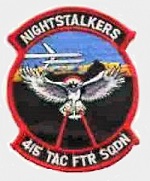Hobby Master HA5802 USAF Lockheed F-117A Nighthawk Stealth Attack Aircraft - 88-0843 "Farewell", 49th Fighter Wing, April 2008 [Retirement Scheme] (1:72 Scale)
"The F-117 was the only airplane that the planners dared risk over downtown Baghdad."
- The United States Air Force
 The Lockheed F-117 Nighthawk is a retired American single-seat, twin-engine stealth attack aircraft that was developed by Lockheed's secretive Skunk Works division and operated by the United States Air Force (USAF). The F-117 was based on the Have Blue technology demonstrator.
The Lockheed F-117 Nighthawk is a retired American single-seat, twin-engine stealth attack aircraft that was developed by Lockheed's secretive Skunk Works division and operated by the United States Air Force (USAF). The F-117 was based on the Have Blue technology demonstrator.
The Nighthawk was the first operational aircraft to be designed around stealth technology. Its maiden flight took place in 1981 at Groom Lake, Nevada, and the aircraft achieved initial operating capability status in 1983. The Nighthawk was shrouded in secrecy until it was revealed to the public in 1988. Of the 64 F-117s built, 59 were production versions, with the other five being prototypes.
The F-117 was widely publicized for its role in the Persian Gulf War of 1991. Although it was commonly referred to as the "Stealth Fighter", it was strictly a ground-attack aircraft. F-117s took part in the conflict in Yugoslavia, where one was shot down by a surface-to-air missile (SAM) in 1999; it was the only Nighthawk to be lost in combat. The U.S. Air Force retired the F-117 in 2008, primarily due to the fielding of the F-22 Raptor.
Pictured here is a spectacular 1:72 scale diecast replica of a F117A Nighthawk stealth attack aircraft that was attached to the 49th Fighter Wing during April 2008.
Sold Out!
Dimensions:
Wingspan: 7-1/4-inches
Length: 11-inches
Release Date: February 2018
 Historical Account: "Escape Now and Save Yourselves" - During the Gulf War in 1991, the F-117 flew approximately 1,300 sorties and scored direct hits on 1,600 high-value targets in Iraq over 6,905 flight hours. Leaflet drops on Iraqi forces displayed the F-117 destroying ground targets and warned "Escape now and save yourselves". Initial claims of its effectiveness were later found to be overstated. For instance it was claimed that the F-117 made up 2.5% of Coalition tactical aircraft in Iraq and they attacked more than 40% of the strategic targets; this ignored the fact that only 229 Coalition aircraft could drop and designate laser-guided bombs of which 36 F-117 represented 15.7%, and only the USAF had the I-2000 bombs intended for hardened targets, so the F-117 represented 32% of all coalition aircraft that could deliver such bombs. Initial reports of F-117s hitting 80% of their targets were later scaled back to "41-60%". On the first night, they failed to hit 40% of their assigned air-defense targets, including the Air Defense Operations Center in Baghdad, and 8 such targets remained functional out of 10 that could be assessed. In their Desert Storm white paper, the USAF claimed that "the F-117 was the only airplane that the planners dared risk over downtown Baghdad" and that this area was particularly well defended. In fact, most of the air defenses were on the outskirts of the city and many other aircraft hit targets in the downtown area, with minimal casualties when they attacked at night like the F-117. This meant they avoided the optically aimed AAA and infra-red SAMs which were the biggest threat to Coalition aircraft.
Historical Account: "Escape Now and Save Yourselves" - During the Gulf War in 1991, the F-117 flew approximately 1,300 sorties and scored direct hits on 1,600 high-value targets in Iraq over 6,905 flight hours. Leaflet drops on Iraqi forces displayed the F-117 destroying ground targets and warned "Escape now and save yourselves". Initial claims of its effectiveness were later found to be overstated. For instance it was claimed that the F-117 made up 2.5% of Coalition tactical aircraft in Iraq and they attacked more than 40% of the strategic targets; this ignored the fact that only 229 Coalition aircraft could drop and designate laser-guided bombs of which 36 F-117 represented 15.7%, and only the USAF had the I-2000 bombs intended for hardened targets, so the F-117 represented 32% of all coalition aircraft that could deliver such bombs. Initial reports of F-117s hitting 80% of their targets were later scaled back to "41-60%". On the first night, they failed to hit 40% of their assigned air-defense targets, including the Air Defense Operations Center in Baghdad, and 8 such targets remained functional out of 10 that could be assessed. In their Desert Storm white paper, the USAF claimed that "the F-117 was the only airplane that the planners dared risk over downtown Baghdad" and that this area was particularly well defended. In fact, most of the air defenses were on the outskirts of the city and many other aircraft hit targets in the downtown area, with minimal casualties when they attacked at night like the F-117. This meant they avoided the optically aimed AAA and infra-red SAMs which were the biggest threat to Coalition aircraft.
The aircraft was operated in secret from Tonopah for almost a decade, but after the Gulf War the aircraft moved to Holloman in 1992 - however its integration with the USAF's non-stealth "iron jets" occurred slowly. As one senior F-117A pilot later said: Because of ongoing secrecy others continued to see the aircraft as "none of their business, a stand-alone system". The F-117A and the men and women of the 49th Fighter Wing were deployed to Southwest Asia on multiple occasions. On their first deployment, with the aid of aerial refueling, pilots flew non-stop from Holloman to Kuwait, a flight of approximately 18.5 hours - a record for single-seat fighters that stands today.


